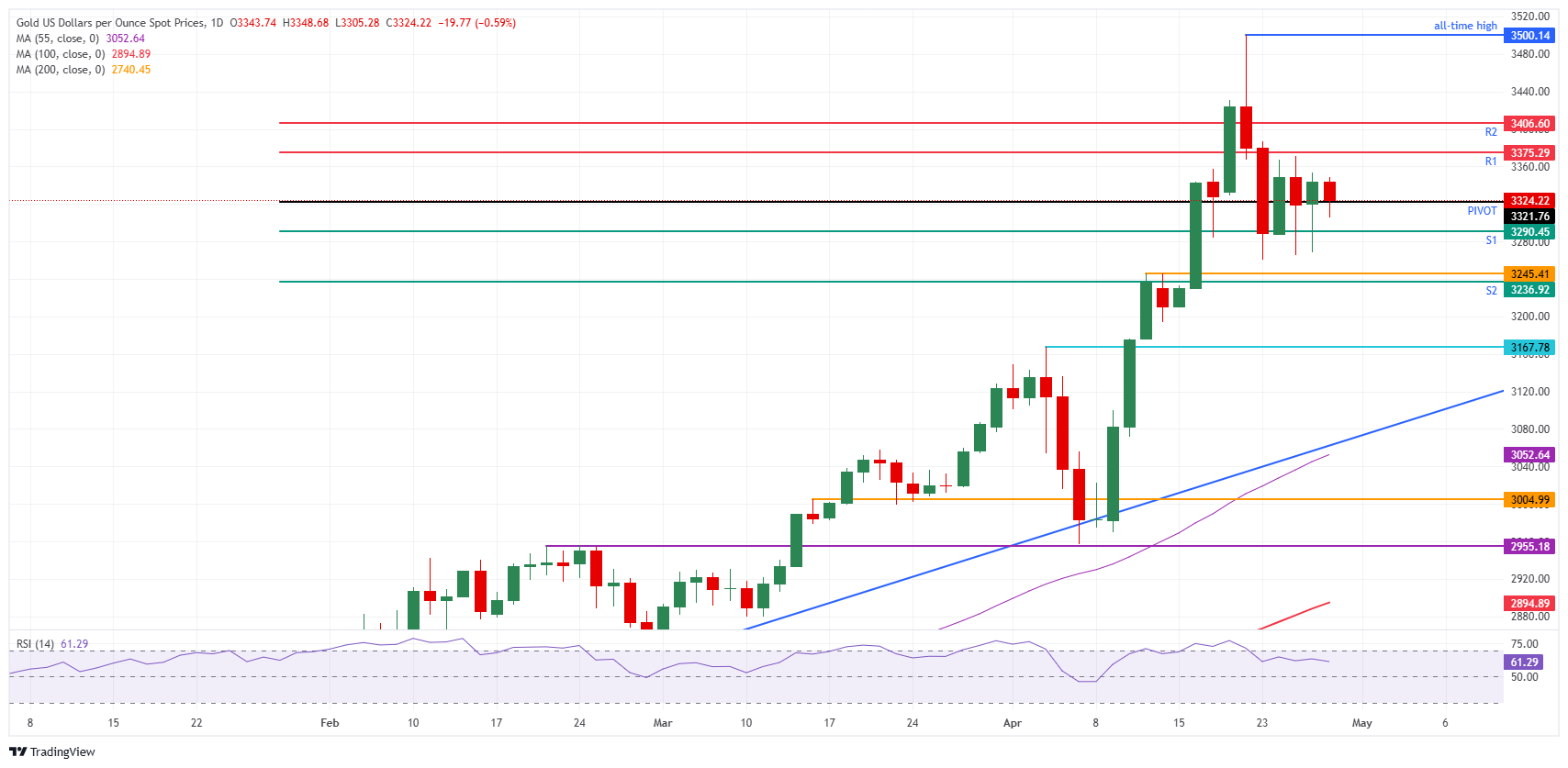Gold consolidates as tariff fears start to fade
- Gold price declines on expectations that US President Trump will ease auto tariffs.
- Traders brace for key US economic data that could influence the Fed’s rate path.
- Despite more bearish elements starting to accumulate, traders still advise keeping Gold positioning.
Gold price (XAU/USD) is entering a consolidation phase and is trading in a more narrow range day by day, currently trading around $3,315 at the time of writing on Tuesday. The consolidation comes as traders and markets tweak their positioning in the precious metal ahead of a possible announcement by United States (US) President Donald Trump on car tariffs. The rumor in markets is that Trump will ease auto tariffs, which would reduce demand for Gold and ease trade tensions, Bloomberg reports.
US economic data will be the second driver this week, which will become important after the Texas Federal Reserve (Fed) Manufacturing Activity Tracker. The widely followed measure weakened significantly as participants expressed their current sentiment with words like “chaos” and “insanity”, in order to describe the turmoil spurred by Trump’s tariffs, the Dallas Fed report mentioned, according to Bloomberg.
Daily digest market movers: Swamped with tariff and Fed headlines
- US Treasury Secretary Scott Bessent told CNBC on Monday that the US has put China on hold for now as it seeks trade deals with between 15 and 17 other countries, while indicating it’s up to Beijing to take the first step in de-escalating the tariff fight, Reuters reports.
- On Monday, the Dallas Fed Manufacturing Business Index for April fell to -35.8, coming from -16.3. The negative doubling plunge in the sentiment index takes the indicator to levels not seen since the pandemic took place, Reuters reports. This could be one of the data points this week, together with the upcoming preliminary US Gross Domestic Product (GDP) for the first quarter due on Wednesday and the Nonfarm Payrolls (NFP) print on Friday, for the Federal Reserve to assess its policy decision for the meeting on May 7.
- China is pushing back hard against the US with the People’s Daily, the flagship newspaper of the Chinese Communist Party, saying in a commentary Tuesday morning that the US should stop its wrongdoing of imposing tariffs. Foreign Minister Wang Yi also said if nations choose to remain silent, compromise and retreat, it will only lead to the bullies making further advances, Bloomberg reports.
Gold Price Technical Analysis: The balance is broken
To keep your hedge or not to keep it, that is the question. Clearly, the Gold rally is stalling and is starting to show signs of fatigue with traders booking profits and reducing their exposures as more and more headlines come out that the Trump administration is starting to reduce its aggressive tariffs regime, for example, with the car parts exemptions. Though, can the US ease off that much if its main competitor and reason for these tariffs, China, is unwilling to come to the table?
The daily Pivot Point at $3,322 has been tested this morning, though, for now, it tries to hold price action. From there, it is quite a stretch to $3,375 before hitting the R1 resistance. The R2 resistance at $3,406 is a near-implausible level to reach this Tuesday, as this consolidation is not yet due for a breakout.
On the downside, the S1 support is providing a cushion at $3,290. Further down, the technical pivotal floor near $3,245 (April 11 high) comes into play. Finally, the S2 support at $3236 should prevent any further downturn to the pivotal level at $3,167 (April 3 high).

XAU/USD: Daily Chart
Gold FAQs
Gold has played a key role in human’s history as it has been widely used as a store of value and medium of exchange. Currently, apart from its shine and usage for jewelry, the precious metal is widely seen as a safe-haven asset, meaning that it is considered a good investment during turbulent times. Gold is also widely seen as a hedge against inflation and against depreciating currencies as it doesn’t rely on any specific issuer or government.
Central banks are the biggest Gold holders. In their aim to support their currencies in turbulent times, central banks tend to diversify their reserves and buy Gold to improve the perceived strength of the economy and the currency. High Gold reserves can be a source of trust for a country’s solvency. Central banks added 1,136 tonnes of Gold worth around $70 billion to their reserves in 2022, according to data from the World Gold Council. This is the highest yearly purchase since records began. Central banks from emerging economies such as China, India and Turkey are quickly increasing their Gold reserves.
Gold has an inverse correlation with the US Dollar and US Treasuries, which are both major reserve and safe-haven assets. When the Dollar depreciates, Gold tends to rise, enabling investors and central banks to diversify their assets in turbulent times. Gold is also inversely correlated with risk assets. A rally in the stock market tends to weaken Gold price, while sell-offs in riskier markets tend to favor the precious metal.
The price can move due to a wide range of factors. Geopolitical instability or fears of a deep recession can quickly make Gold price escalate due to its safe-haven status. As a yield-less asset, Gold tends to rise with lower interest rates, while higher cost of money usually weighs down on the yellow metal. Still, most moves depend on how the US Dollar (USD) behaves as the asset is priced in dollars (XAU/USD). A strong Dollar tends to keep the price of Gold controlled, whereas a weaker Dollar is likely to push Gold prices up.

